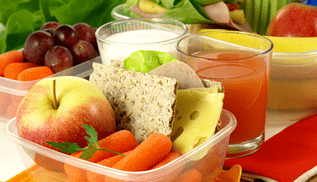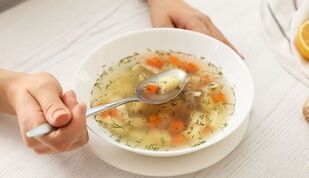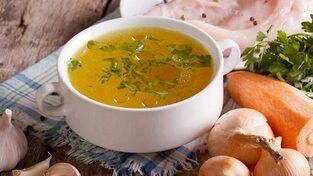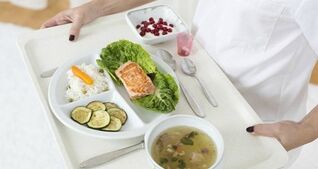
The list of functions of the human pancreas includes the production of most digestive enzymes, without which the normal course of vital processes in the gastrointestinal tract is impossible, as well as the synthesis of insulin. When a malfunction of this organ occurs, inflammation of the pancreas develops. This disease is caused by inflammation of the pancreas, usually a suspension of the normal secretion of enzymes.
Nutritional Peculiarities in Acute and Chronic Pancreatitis
In the absence of pathologies in the body, enzymes enter the intestines, but as a result of inflammation of the pancreas, they remain inside this organ and begin to gradually corrode its inner shell. Quite often, patients with inflammation of the pancreas develop poisoning, which results in intestinal particles and enzyme residues entering the bloodstream. The acute course of the disease usually ends with surgery if therapy and diet do not give the desired result.
Chronic pancreatitis is usually caused by overconsumption, alcohol or drug use, hormonal or estrogenic medications, and pre-existing diseases of the gallbladder and liver. For two types of this disease, gastroenterologists recommend following a special diet for pancreatitis, which includes preparing an approximate menu.
Acute pancreatitis: diet menu for the week
In order to normalize the patient's body, the nutritionist prescribes a special therapeutic diet to prevent the pancreas from swelling and inflaming. In addition to medication, short-term fasting is also prescribed, thus avoiding surgery. During fasting, the production of gastric juice ceases and the activity of enzymes also decreases, which helps the damaged organ to recover in a few days.
In the first days of such a fast, it is recommended to drink small doses of mineral medicinal water without gas, diluted green tea or rosehip soup several times a day. Drinking can help prevent dehydration, but once you get out of fasting, you should gradually switch to eating. In the presence of acute pancreatitis, a strict diet is followed, the weekly menu should be prepared by a specialist. The 5-day regular diet includes the following foods:

- dry bread or a loaf of wheat flour;
- liquid jellies or fruit drinks;
- slimy rice or oatmeal soup;
- liquid mashed potatoes without added oil;
- pureed cereals such as oatmeal, rice, semolina or buckwheat;
- dry biscuits;
- Bread or biscuits.
After 6 days, other foods and beverages can be added to the Pancreatitis menu. It can be black or green tea sweetened with a small amount of sugar or honey with the addition of milk, beet juice with a small amount of mineral water. The list of allowed foods includes:
- steamed protein omelette;
- cottage cheese souffle;
- minced or minced meat;
- liquid slimy soups;
- berry or apple foams and gels;
- Steamed vegetable puree and custard without oil.
Sample menu for pancreatitis for a week
The diet for acute pancreatitis should be fairly strict, so the patient should follow the menu prepared for him for a week. An example of such a diet is given below, but the exact list of foods should be discussed with your doctor.
Day 1
- Breakfast. Liquid porridge made from rice or wheat groats with the addition of a fruit such as orange, pear or apple, weak tea with honey.
- Late breakfast. Puree pumpkin puree, steamed fish or minced chicken slices, rosehip soup.
- Lunch. Fish or beef soup, mashed potatoes, dried white bread, baked apples as a dessert.
- Afternoon snack. Small portions of cottage cheese and weak tea with added honey.
- Dinner. Protein steam omelette, dry white bread, mashed vegetable puree.
Day 2
- Breakfast. Milk oatmeal, jelly or tea (green or black).
- Late breakfast. Apple sauce mixed with cottage cheese.
- Lunch. Broccoli or cauliflower puree, steamed chicken dumplings.
- Afternoon snack. Dry biscuits and green tea.
- Dinner. Rice or cottage cheese pudding, jelly or tea.
Day 3
- Breakfast. Rice-based liquid porridge with green tea and a dry cookie.
- Late breakfast. Baked apples with honey or cottage cheese.
- Lunch. Vegetable soup, cauliflower, potatoes, green peas or carrots, combined with meatballs, dried fruit compote.
- Afternoon snack. Pureed cottage cheese and weak tea.
- Dinner. Lean fish, fried or steamed.
General recipes

The sample menu may contain special recipes for pancreatitis. To prevent the condition from deteriorating, all the ingredients in each dish should be coordinated with a doctor or nutritionist, who will usually recommend the preparation of the first and second courses and special desserts themselves.
Pumpkin and carrot puree
To make such a dietary puree, you need 400 grams of pumpkin and two carrots, which must be peeled and cut into medium cubes. Then cook the vegetables in boiling water until soft enough. After cooking, the water from the pot can be completely or partially emptied to obtain a thinner mass. Using a blender, the vegetables should be turned into a homogeneous mass and served.
Fish soup
To make a liquid pasty soup, you need to take half a kilogram of lean fish, such as cod, hake, perch or flounder, one and a half liters of water, a teaspoon of butter, and 50 ml of milk. The fish fillet is cut into small pieces and boiled in water or vegetable soup. Bring the separately preheated milk to a boil with the butter melted in it, pour in the fish soup and add the fillets, then cook everything together for a few minutes.
It should be borne in mind that in the acute form of pancreatitis, it is strictly forbidden to eat fatty and fried foods, foods that stimulate the digestive system to ferment, alcohol, kvass, kefir and carbonated drinks.
Pancreatitis menu
As for the pancreatitis diet and an exemplary menu, many gastroenterologists recommend following the well-known diet No. 5, which is usually prescribed when the patient's condition has improved in the acute form of the disease. Foods allowed as part of a diet can be safely included in the diet after fasting. Usually, such a diet is divided into two stages, each of which differs in time.
During the first phase, you can only take pureed food for two weeks, after which the patient is transferred to the second, less strict menu item, which lasts for at least six to eight months. In the first stage, you can consume liquid, unsalted foods, predominantly with carbohydrates, drink fruit drinks, fruit juices, rosehip decoctions with the addition of honey or sugar. Fatty, fried or salty foods are strictly forbidden.
After the fifth day of the diet, you should gradually increase your calories while limiting your fat intake. From the sixth to the ninth day of such a diet, the total caloric content of the foods consumed daily should not exceed 1000 calories. After the tenth, the number of calories can be increased and the patient is transferred for a week to the second dietary option for pancreatitis.
Nutrition for the chronic form of the disease

Pancreatitis often becomes chronic, in which case special diets for pancreatitis are more relevant than ever, allowing the condition of the gastrointestinal tract to be fully normalized. Due to malnutrition, periodic seizures occur periodically, especially when the list of foods includes prohibited foods, including boiled eggs, sweets, chocolate, milk, soda, and other similar foods. Symptoms of the disease: bloating, noticeable difficulty after the next meal, frequent vomiting. Quite often, chronic inflammation of the pancreas provokes the development of diabetes mellitus, especially in cases where the patient did not see a doctor in time and did not start taking special medications.
For a week, the dietitian or gastroenterologist will need to develop a special menu for pancreatitis that includes light and fast-digesting foods. It will be especially helpful to drink mineral water for two days without gas, as well as a decoction of wild rose or weak weak tea. You should switch to a low-calorie diet as soon as possible, prepare meals with minimal fat and carbohydrates. Food intake should be fragmentary, with at least 5-6 meals a day. The list of products on the chronic pancreatitis menu should include:
- wheat rusks (purchased or made independently);
- liquid vegetable or cereal soups;
- roasted or cooked meat, including chicken, veal or rabbit;
- steamed lean fish;
- low-fat cottage cheese;
- unsalted and low fat cheeses;
- semi-liquid and liquid cereals;
- vegetable puree and stew;
- fried and grated fruits;
- Light jelly, foam and compote.
Sample menu and list of prohibited foods
The menu for chronic pancreatitis in adults and children should certainly be varied, despite the rather strict restrictions, while carefully monitoring daily routine and hourly meals. Usually, a weekly menu is prepared by a specialist who gives detailed instructions and advice to the patient, helps to select the right recipes for the food, and talks about the properties of each product. You may want to pay attention to the approximate menu of pancreatitis that you can focus on when preparing your own diet:
- Breakfast. Oatmeal with milk and rosehip decoction.
- Second breakfast. Steamed chicken or beef, weak tea.
- Lunch. Carrot and pumpkin puree soup with steamed fish and tea.
- Afternoon snack. Cottage cheese for baby food.
- Dinner. Zucchini with roasted carrots, boiled chicken breast, dried fruit compote.
- Evening meal. A glass of low-fat kefir.
The diet and approximate menu for pancreatitis are severely restricted, as many foods can overstimulate pancreatic secretion and gastric juice production. The list of prohibited products includes:
- fatty meats and fish, smoked meats, sausages and preserves;
- meat and fish soup and mushroom soup;
- cabbage soup, beets, okroshka;
- fatty dairy products;
- fried and boiled eggs;
- all kinds of legumes, white cabbage, radishes, onions, garlic, spinach, sorrel, eggplant, bell peppers and mushrooms; butter and flour bakery products, confectionery, chocolate;
- Coffee, black strong tea, cocoa, carbonated drinks.
Recipes for Chronic Pancreatitis

The diet and proper menu for pancreatitis should be selected by a specialist, and patients should learn a number of new recipes that are ideal for normalizing the digestive system.
Mashed vegetable soup
To prepare an unsweetened yellow or green pepper, 200 g of broccoli and cauliflower, 1 zucchini is required. Cut the vegetables into cubes, add 1, 5 liters of water and cook until soft. You will then need to drain the water and use a blender to make mashed potatoes.
Alma Pastila
To make a healthy diet marshmallow you need 1 kg of apples, cut into cubes and peeled, put in a pan, add water and let it cook. Once cooked, you need to remove the pan from the fire, let off the water and cool the apples. It is then crushed with a blender, the resulting puree is squeezed out and the excess juice is poured into a separate container. Then boil the juice separately in a pan until it thickens, add 100 g of liquid honey and cook until a syrup is obtained. The juice is then mixed with mashed potatoes, the mass is spread on a baking sheet and placed in a preheated oven at 120 degrees to allow the marshmallows to dry.
Doctor's recommendations
In most cases, a diet for pancreatitis and adherence to a strict menu for a week will give excellent results, as such a nutritional system has a very gentle effect on the internal organs. Doctors say the results of such diets show that the work of the pancreas is stabilized, mainly due to a decrease in the concentration of gastric juice. Experts recommend that you completely eliminate alcohol during your treatment and follow a balanced and proper diet at all times. In addition to improving your digestive system, you can significantly reduce your weight and improve your overall condition thanks to a menu with inflammation of the pancreas and light meals.




























